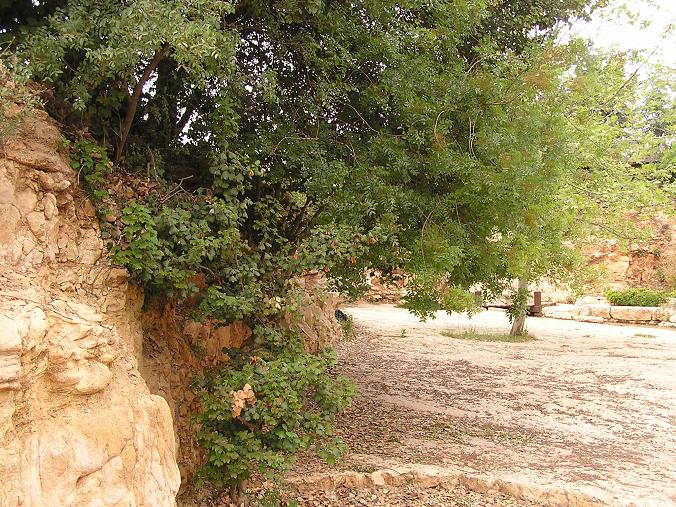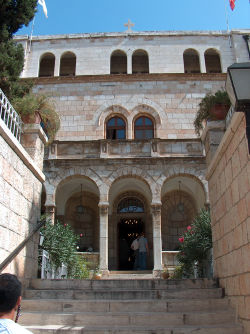This cache was hidden as part of the Geocaching 10 years
celebrations in Israel.
Jerusalem is known for its stone buildings. A local law, since
the days of British occupation, requires every building in
Jerusalem to be built of stone, or coated by stone.

The building stone that gives Jerusalem its character is locally
quarried limestone. There are seven grades of building stone, which
are quarried from distinct beds of the Mount Scopus and Judea
Groups. These are, in descending stratigraphic order:
- Nari
Nari is a harder crust formed on soft surface chalk or marl of the
Mount Scopus Group (Senonian), which overlies more resistant
limestone beds of the Judea Group. Nari is used as a source of lime
today, but its friability or ease of cutting made it the favorite
material for ashlars or dressed building stones during the tenth
and ninth centuries BC.
- Kakula
Kakula is white or bituminous chalky limestone from the Mount
Scopus Group. It is easily carved or turned and was used in
biblical times for ossuaries, or receptacles for the bones of the
dead, and ritually pure stone vessels. Although porous and friable,
its low density made kakula useful for roofing. Archeologist
Yitzhak Magen has excavated a cave at Hizma, north of Jerusalem,
which contains the remains of a workshop for stone vessels, and he
has reconstructed the techniques that artisans used to shape
vessels such as the six klal or stone water jars of Cana (John
2:6).
- Mizzi hilu
Mizzi hilu ("sweet stone") is a hard, ledge-forming lithographic
limestone member of the Judea Group (Turonian), which workers
customarily leave in place as the roof of a cave after quarrying
the underlying meleke.
- Meleke
This is the most known stone in Jerusalem, the stone which is used
for many of the old buildings of Jerusalem. Meleke ("queen") is the
preferred, moderately hard, crystalline limestone member of the
Judea Group (Turonian), which is easily quarried for building
stone. Its working properties and attractive golden color make it
the preferred building stone today. Ashlars in the Wailing Wall,
the outer retaining wall of the extended Herodian Temple platform,
were apparently cut from meleke in quarries north to the Mount of
Temple. It keeps its color for years, giving to those buildings
their typical look.

Meleke in the Wailing Wall
- Mizzi ahmar
Mizzi ahmar ("red stone") is a reddish dolomitic limestone member
of the Kefar Veradim Formation (Cenomanian). It was used for
building since the 2nd temple days. In late 19th and early 20th
centuries it was used as a decorative stonework for luxury houses.
It underlies the meleke.

Meleke and mizzi ahmar integrated in the Austrian hostel in
Jerusalem
- Mizzi Yahudi
Mizzi yahudi ("Jewish stone") is a dolomitic limestone member of
the Kefar Veradim Formation (Cenomanian). It is the most common
used stone for building in Jerusalem, since the begining of 20th
century.
- Dir yassini
Dir yassini is a platy reddish dolomitic limestone member of the
Kefar Sha'ul Formation. It appears as thin slabs of 10-25cm,
seperated by marl. Marl is a calcium carbonate or lime-rich mud
which contains variable amounts of clays and aragonite. It forms a
layer which is sealed to water, forming most of the spring in
Jerusalem area. The thin layers of Dir yassini are used for floors
and roofs.
In the early 20th century, Jerusalem was rapidly expanded, with
many new neighborhood built outside the old city walls. Many
quarries were opened to supply the building needs - in Lifta,
Giv'at Shaul, Givat Beit Ha'Kerem and all the area of Giv'at Ram
where today are the Hebrew university, the Knesset, The Israel
Museum and Neve Granot. A small remnant for these quarry was
integrated in the Wohl garden and roses, the place of this Earth
cache. Today there are a nice Japanese garden and waterfall.
Sadly, today you can see the stones of Jerusalem on buildings
from all eras, but less ans less in their natural form.
Earth cache does not involve a physical cache. While visiting
the place, please look and answer the following questions. Send the
answer to the
cache owner and log it only after you get back the permission.
The important thing is not your right answer but trying to learn,
so even if you give me wrong answer, but which are based on true
observations from the site, you will get permission to log
find.
- Look on the quarry walls, near the waterfall (the waterfall is
somtimes dry because the shortage of water, but you can identify
its place). What is the color of the stone? Which stone of the
above do you think it is?
- On the bottom of the quarry flowing an artifical stream (again,
it may be dry). Measure the height of the step above the stream
channel (If you don't have a ruler, mark it on something and
measure at home). What do you think is the stone above the stream?
What is in its bottom?
- Some stones in the place were brought here from other areas.
Describe at least one such stone and why do you think it is from
other place?